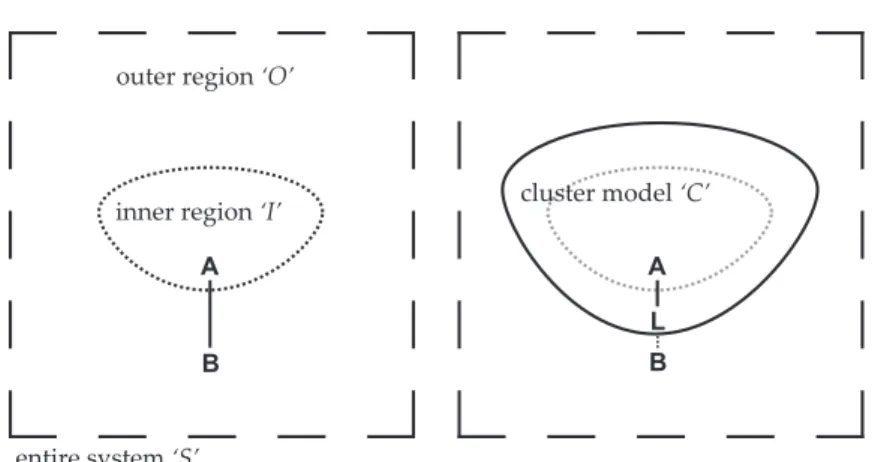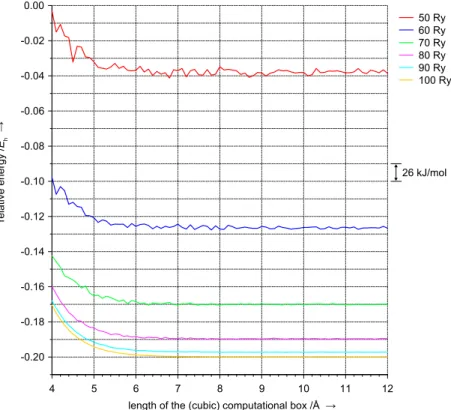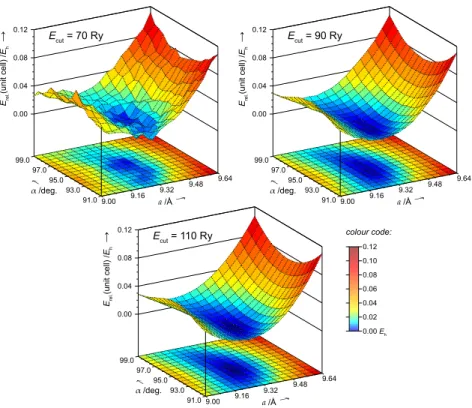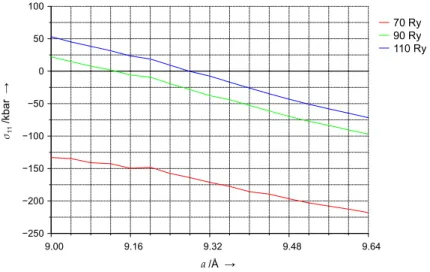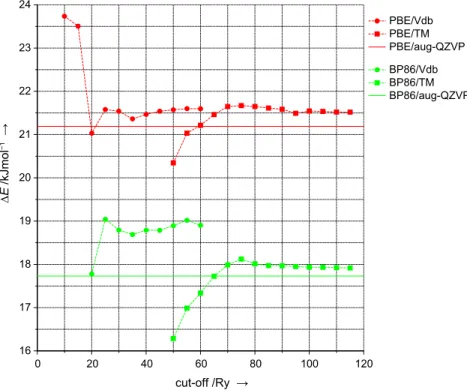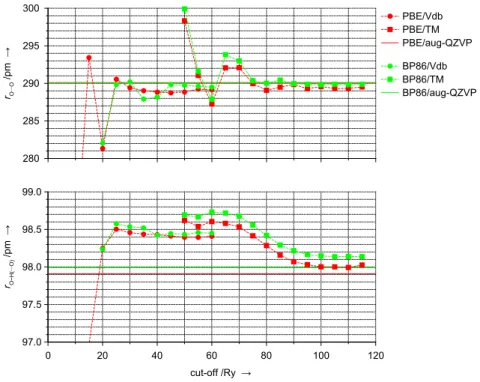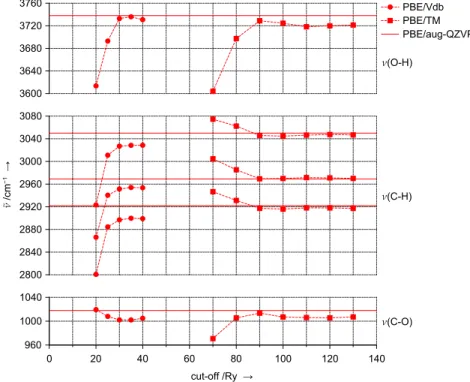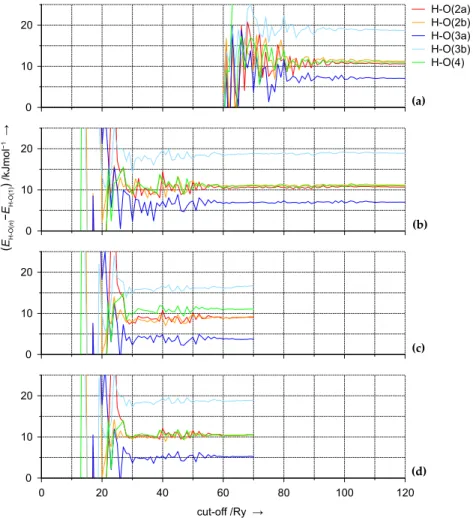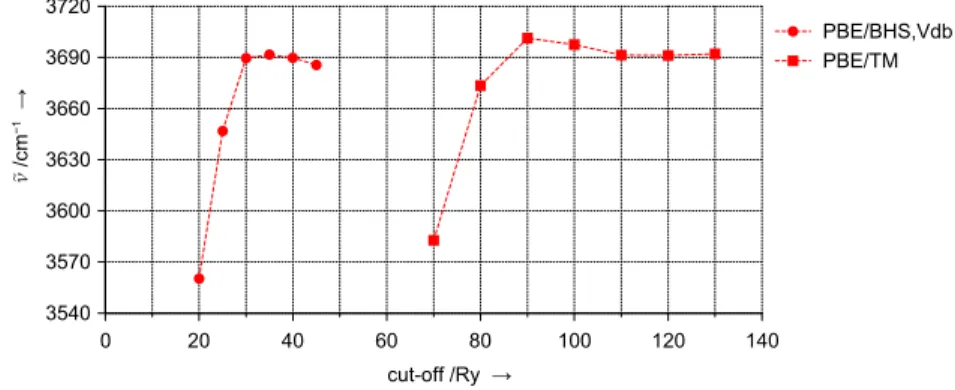MP2/P LANE -W AVE -DFT S TUDIES OF
E XTENDED S YSTEMS
D i s s e r t a t i o n
zur Erlangung des akademischen Grades d o c t o r r e r u m n a t u r a l i u m
(Dr. rer. nat.) im Fach Chemie eingereicht an der
Mathematisch-Naturwissenschaftlichen Fakultät I der Humboldt-Universität zu Berlin
von
Herrn Dipl.-Chem. Christian Tuma geboren am 04.11.1974 in Berlin Präsident der Humboldt-Universität zu Berlin
Prof. Dr. Christoph Markschies
Dekan der Mathematisch-Naturwissenschaftlichen Fakultät I Prof. Dr. Christian Limberg
Gutachter: 1. Prof. Dr. Joachim Sauer 2. Prof. Dr. Matthias Scheffler 3. Prof. Piero Ugliengo
Tag der mündlichen Prüfung: 14. Dezember 2006
Abstract
Due to their comparatively high efficiency standard methods in density functional theory (DFT) belong to the most popular computational ap- proaches in quantum mechanics (QM). In certain applications, however, widely used density functionals do not yield reliable results. This ap- plies, for example, to the calculation of activation barriers or dispersive interactions. Problems of this type can be overcome in principle by using electron correlation methods, but in many cases too high computational costs rule out their application. The simplest QM method for electron correlation, second-order Møller–Plesset perturbation theory (MP2), de- scribes dispersion well.
In this work a hybrid method solely based upon QM approaches is presented, combining advantages of both DFT and electron correlation methods. DFT calculations are performed for the full system and an embedded cluster model representing the active site. To this end an atomic pseudopotential plane wave approach, computationally well suited for periodic systems, is chosen. DFT implementations of this type are rarely used in computational chemistry, and for this reason test calculations are performed to ensure sufficient accuracy in subsequent applications.
The cluster model is also calculated with MP2. Thus corrections for DFT energy and energy gradient results are obtained and applied to the full system. Stationary points on the potential energy surface defined this way are localised employing standard structure optimisation techniques.
The reliability of the results obtained with this hybrid method is fur- ther improved by extrapolation to the limiting case of a complete basis set and an infinitely large cluster model. Employing plane waves in the DFT part the limit of a virtually complete basis set can be accomplished easily in a systematic manner. For MP2 commonly used extrapolation schemes are applied, requiring additional effort to account for the basis set superposition error. MP2 corrections to DFT reaction energies, which, in first approximation, can be attributed to the neglected long-range part of dispersion, are determined for a systematic series of cluster models of increasing size. These corrections are used for fitting a parametrised dampedC6pair potential. For all models, including the full system under
periodic boundary conditions, the fitted potential is employed to obtain corrections to DFT reaction energies, that is, to estimate MP2 reaction en- ergies. Small model systems are used in coupled-cluster reaction energy calculations to verify the reliability of MP2.
Application of the hybrid method is demonstrated in the field of het- erogeneous catalysis. Case studies are the investigation of proton jump reactions in the zeolite chabazite and protonation reactions of isobutene in the zeolite ferrierite. The MP2/DFT results obtained confirm that acti- vation barriers are clearly underestimated with purely gradient corrected density functionals. Rate constants are corrected by up to two orders of magnitude. It is shown further that for adsorption and chemisorption of hydrocarbons in zeolites reaction energies can hardly be predicted with DFT. MP2 corrections obtained are in a range from–29 to–70 kJ/
mol and, even more important, are not the same for different products.
Of all structures investigated the surface alkoxides benefit most from an improved consideration of dispersion. Thetert-butyl carbenium ion, hydrogen-bonded to the zeolite framework, is much less stable than pre- dicted with DFT. The calculated MP2 heat of adsorption of isobutene in ferrierite (–74+–10 kJ/mol) corresponds to experimental results for similar systems and underlines the reliability of the hybrid MP2/DFT approach presented in this work.
Keywords:
density functional theory, hybrid methods, dispersion interaction, zeolite catalysts
Zusammenfassung
Standardmethoden der Dichtefunktionaltheorie (DFT) gehören aufgrund ihrer vergleichsweise hohen Effizienz zu den beliebtesten quantenme- chanischen (QM) Rechenverfahren. Es gibt jedoch Anwendungsfälle, in denen gegenwärtig häufig eingesetzte Funktionale keine verlässlichen Ergebnisse liefern. Dazu gehören beispielsweise Berechnungen von Di- spersionswechselwirkungen und oft auch von Aktivierungsbarrieren.
Probleme dieser Art lassen sich durch den Einsatz von Elektronenkor- relationsmethoden prinzipiell lösen, was in der Praxis jedoch häufig an einem zu hohen Rechenaufwand scheitert. Der einfachste Ansatz zur ex- pliziten Berücksichtigung der Elektronenkorrelation, und damit auch der Dispersionswechselwirkung, ist Møller–Plesset Störungstheorie zweiter Ordnung (MP2).
In der vorliegenden Arbeit wird eine auf ausschließlich quantenmecha- nischen Verfahren basierende Hybridmethode vorgestellt, die die Vorzüge von DFT und Elektronenkorrelationsmethoden miteinander kombiniert.
Dabei erfolgen zunächst DFT-Berechnungen sowohl für das Gesamtsys- tem als auch für ein darin eingebettetes Clustermodell, welches das akti- ve Zentrum darstellt. Hier kommt eine Implementierung mit atomaren Pseudopotentialen und Basisfunktionen aus ebenen Wellen zum Einsatz, was insbesondere für periodische Systeme von rechtentechnisch großem Vorteil ist. Da DFT-Programme dieser Art in der Quantenchemie wenig populär sind, wurden Testrechnungen durchgeführt, um die nötige Ge- nauigkeit in späteren Anwendungen zu garantieren. Das Clustermodell wird außerdem mit MP2 beschrieben, wodurch Korrekturen gegenüber den DFT-Ergebnissen für die Energie und den Energiegradienten ableitbar sind, die auf das Gesamtsystem angewendet werden. Zur Lokalisierung stationärer Punkte auf der so definierten Potentialfläche kommen Stan- dardverfahren der Strukturoptimierung zum Einsatz.
Die Zuverlässigkeit der mit dieser Hybridmethode erzielten Ergeb- nisse wird zusätzlich durch Extrapolation auf den Grenzfall eines voll- ständigen Basissatzes und eines unendlich großen Clustermodells erhöht.
Im DFT-Teil kann durch die Verwendung ebener Wellen das Limit einer praktisch vollständigen Basis systematisch und schnell erreicht werden.
Für MP2 werden bekannte Extrapolationsverfahren eingesetzt, die je- doch zusätzlichen Aufwand durch Korrekturen für den hier auftretenden Basissatzüberlagerungsfehler erfordern. MP2-Korrekturen für DFT-Reak- tionsenergien, die in erster Näherung auf den mit DFT vernachlässigten, langreichweitigen Dispersionsanteil zurückzuführen sind, werden für eine systematische Reihe von unterschiedlich großen Clustermodellen ermittelt. Daran wird ein parametrisiertes, gedämpftesC6-Paarpotenti- al angepasst, das schließlich auch für das Gesamtsystem (periodische Randbedingungen) die Abschätzung einer MP2-Korrektur der DFT-Re- aktionsenergie, und damit eines reinen MP2-Ergebnisses, erlaubt. An kleinen Modellen wird ein hochgenaues coupled-cluster Rechenverfah- ren eingesetzt, um gegebenenfalls Korrekturen der Ergebnisse über MP2- Qualität hinaus zu erzielen.
Erste Anwendungen dieser Hybridmethode erfolgen auf dem Gebiet der heterogenen Katalyse. Dazu werden exemplarisch Protonensprungre- aktionen im Zeolith Chabasit und Protonierungsreaktionen von Isobuten im Zeolith Ferrierit untersucht. Die gewonnenen MP2/DFT-Ergebnisse bestätigen, dass Aktivierungsbarrieren mit einfachen Dichtefunktionalen deutlich unterschätzt werden. Geschwindigkeitskonstanten sind nach Korrektur um ein bis zwei Größenordnungen kleiner. Weiterhin kann ge- zeigt werden, dass Reaktionsenergien für die Adsorption und Chemisorp- tion von Kohlenwasserstoffen in Zeolithen mit DFT qualitativ schlecht vorausgesagt werden. MP2-Korrekturen sind für die verschiedenen Reak- tionsprodukte unterschiedlich groß und liegen in einem Bereich von–29 bis–70 kJ/mol. Oberflächenalkoxide profitieren energetisch am meisten durch die verbesserte Berücksichtigung der Dispersionswechselwirkung, während dastert-Butylcarbeniumion, das über eine Wasserstoffbrücke mit dem Zeolithgerüst verbunden ist, eine deutlich geringere relative Stabilität aufweist, als nach den DFT-Ergebnissen vermutet werden kann.
Die berechnete MP2-Adsorptionswärme des Isobutens im Zeolith Ferrie- rit (–74+–10 kJ/mol) entspricht experimentellen Ergebnissen an ähnlichen Systemen und unterstreicht die Zuverlässigkeit des in dieser Arbeit vor- gestellten MP2/DFT-Hybridansatzes.
Schlagwörter:
Dichtefunktionaltheorie, Hybridmethoden, Dispersionswechselwirkung, Zeolithkatalysatoren
Contents
1 Introduction 1
1.1 Motivation . . . 1
1.2 The QM-Pot Embedding Scheme . . . 4
1.3 Issues of the Hybrid MP2/DFT Approach . . . 8
2 Validation of Computational Parameters 11 2.1 Plane Wave DFT Calculations . . . 11
2.1.1 Plane Wave Basis Sets . . . 13
2.1.2 Atomic Pseudopotentials . . . 20
2.1.3 Density Functionals . . . 30
2.2 MP2 Calculations . . . 34
2.2.1 FC and RI Approximations . . . 34
2.2.2 Extrapolation to the MP2 CBS Limit . . . 40
3 Water-Assisted Proton Jumps in Acidic Chabazite 45 3.1 Introduction . . . 45
3.2 Models and Methods . . . 46
3.3 Results and Discussion . . . 50
3.4 Conclusion . . . 55
4 Protonation Reactions of Isobutene in Acidic Ferrierite 57 4.1 Introduction . . . 57
4.2 Models and Methods . . . 60
4.3 Results and Discussion . . . 69
4.4 Conclusion . . . 84
5 Concluding Remarks 87
Bibliography 89
Appendices
A Vibrational Frequencies 123
A.1 The System Chabazite/(Water) . . . 123 A.2 The System Ferrierite/Isobutene . . . 128
B Further Numerical Data 135
Chapter 1
INTRODUCTION
1.1 M
OTIVATIONIn computer simulations of materials and molecular systems the use of Kohn–Sham density functional theory (DFT) [1–7] has met with great success. Today DFT is the computationally most efficient quantum me- chanical (QM) approach applicable to a wide range of chemical systems.
Advanced algorithms and various approximation schemes [8–10] allow for low-order scaling DFT implementations suitable to study extend- ed molecular and periodic systems relevant in,e. g., different fields of catalysis research. This applies to the pseudopotential plane wave DFT approach used throughout the present work. Special care, however, must be taken when DFT is employed for certain types of problems. These include weak interactions and activation barriers (see,e. g., refs. [7,11–22]
and literature cited therein) which will be addressed in the context of this work.
The exact density functional for exchange and correlation is unknown.
A large number of different proposals exists, and in light of the prob- lems unsolved so far much effort is spent to find approximations to the true functional better than those available today [23]. One strategy for improvement is to satisfy purely physical conditions valid for the true functional and to reduce the number of parameters as much as possible [24]. Based on the local density approximation (LDA) such non-empirical improvements incorporate the first derivative of the electron density (gen- eralised gradient approximation, GGA) or higher derivatives (meta-GGA), or the admixture of exact exchange (hybrid functionals). A different (i. e.,
empirical) way is to start from a parametrised expression for the true functional and to fit its parameters to reproduce reference data of selected training systems (see,e. g., ref. [25]).
Experience shows that hybrid functionals usually yield reliable re- sults in many chemistry related applications of DFT. Pure GGA type functionals, however, are known to show typical deficiencies like,e. g., underestimation of reaction barriers. Unfortunately, the calculation of exact exchange (Fock exchange) is computationally very expensive with a plane wave basis set. For this reason plane wave DFT applications usually employ a GGA type density functional and, hence, potentially face the difficulties mentioned above.
Another problem present with any of the available standard density functionals is the complete neglect of the long-range part of dispersion in- teraction. This is an active field of research, and different types of solution have been put forward. Certain types of non-empirical density function- als yield some dispersion at least for short interatomic distances [21], and attempts to parametrise the different exchange and correlation terms in hybrid meta-GGA functionals show further improvements in the range of overlapping densities [26]. For a reliable description of dispersion interaction one can split the exchange–correlation functional and treat the long-range part in a more advanced fashion. Long-range exchange is either calculated exactly or approximated by a GGA that yields qualita- tively correct exchange. The long-range part for correlation, however, is much more difficult to obtain. Functionals depending on the densities of two sub-systems have been suggested [27,28] as well as treatments based on second-order perturbation theory [29]. Random-phase approximation and related time-dependent DFT methods account for the correlation energy by the adiabatic connection fluctuation–dissipation theorem but do not seem to be suitable for large systems due to the steep scaling of the operation count with increasing size of the system [30–32]. A fully empir- ical and computationally cheap solution is adding a damped dispersion term to standard density functionals calculated from parametrised atom–
atomC6contributions [33–37]. Schemes for the direct calculation ofC6
coefficients using time-dependent DFT [38] or conventional DFT [39, 40]
have also been proposed.
Dispersion is a dynamic effect caused by the correlated movement of electrons. Wavefunction theory (WFT) approaches beyond the Hartree–
Fock (HF) method [41–45], by definition, do account for electron corre- lation. The single-particle single-determinant HF description of many- particle interactions can be extended by perturbation theory or by cou- pled-cluster approaches to cover dynamical correlation while, in parallel, multi-reference descriptions can be introduced for non-dynamical correla- tion (see,e. g., refs. [46–50] and literature cited therein). These so-called
“postHF” approaches represent methodological hierarchies of increasing accuracy for the explicit treatment of electron correlation. Unfortunately, the computational effort associated with these methods increases rapidly with growing size of the system. In practical calculations highest accuracy can only be achieved for systems containing a few atoms. The simplest method for the explicit treatment of electron correlation is second-order Møller–Plesset perturbation theory (MP2) [51,52] which will be used extensively in this work. The application of DFT is computationally much cheaper, but—as opposed topostHF schemes—systematic improvements of the DFT Hamiltonian, in particular of the exchange–correlation func- tional, do not exist.
The motivation behind the present work is the idea of a hybrid ap- proach combining the computational efficiency of DFT and the reliable description of electron correlation bypostHF methods. A hybrid QM/
QM embedding implementation is presented forab initiostudies of ex- tended systems including periodic boundary conditions. Plane wave DFT is applied to the full (periodic) system and to embedded cluster models representing the reaction site while the latter are also calculated using MP2. This way the problems encountered with standard DFT (see above) can be effectively eliminated in many cases, and structures and reaction energies for extended systems of currently unsurpassed quality are obtained.
The present work is organised as follows. This chapter introduces theQM-Pot mechanical embedding scheme and details of the hybrid MP2/DFT approach. Chapter 2 addresses computational issues relat- ed to pseudopotential plane wave DFT as well as Gaussian basis set MP2 calculations. Its main purpose is to show that the pseudopotential plane wave DFT approach developed in the physics community can also be successfully applied in chemistry. This, however, requires a careful choice of the computational parameters which, in turn, is not necessarily straightforward and might need extensive preparatory tests. Selected
examples from current topics in the broad field of zeolite catalysis are taken to demonstrate the functionality and the use of the hybrid MP2/
DFT scheme. Water adsorption and proton jump reactions in Brønsted acid chabazite are studied in Chapter 3. A more complex and challenging case is the investigation of adsorption and chemisorption reactions of isobutene in Brønsted acid ferrierite carried out in Chapter 4.
1.2 T
HEQM-P
OTE
MBEDDINGS
CHEMESystems of interest in,e. g., solid-state physics or biochemistry are usually too large for a full QM treatment. For this reason embedding methods have been developed. They have a long tradition in computational chem- istry, and it is beyond the scope of the present work to give a full account on their history and recent developments. Instead, the reader is referred to published work [7, 53–64].
Common to all embedding schemes is the partitioning of the entire system under study, that is, the definition of a region‘I’containing the active site which is calculated at high level (QM).1The remaining part of the system,‘O’, is described at low level. When the interaction between both parts is considered, a simple equation can be written describing the energy of the complete system (see left panel in Fig. 1.1),
E(S) =E(I)high+E(O)low+E(I↔O) . (1.1) A consistent definition of the interaction term,
E(I↔O) =E(S)low−E(I)low−E(O)low , (1.2) turns the additive scheme in eqn. (1.1) into a subtractive scheme,
E(S) =E(I)high+E(S)low−E(I)low . (1.3) The latter can be the more convenient case because the calculation of one of the artificially created subsystems (‘O’) is avoided here. Regarding the interaction between the inner and the outer part, the termmechanical embeddingis used when force fields or, more general, potential functions
1 Extension to treat multi-centred systems is feasible [65].
inner region ‘I’
outer region ‘O’
cluster model ‘C’
A
B
A
B L
entire system ‘S’
Figure 1.1: Split of the entire system ‘S’ (e. g., the unit cell of a periodic structure) and construction of a cluster model ‘C’ to saturate dangling bonds of the inner part ‘I’
are employed as the low-level method in eqn.(1.2). Inelectronic embed- dingschemes the Hamiltonian for the QM treatment of the inner region is augmented by terms accounting for the influence of the outer region (see, in addition, refs. [66–71] for examples).
The inner part, however, needs further consideration. Since only in certain cases the high-level region can be defined without breaking chemical bonds between atoms A and B of the inner and outer part, respectively, the problem of terminating the inner part emerges inevitably.
A straightforward way is to add link atoms (usually hydrogen) to saturate dangling bonds [72–78]. Since hydrogen atoms do not necessarily show the same properties as the atoms they replace, one can also define a boundary region containing specially parametrised connection atoms [79]
or use pseudopotentials [80–82] to mimic the influence of atoms in the outer region. A further approach is to constrain orbitals localised in the terminating region [83–85].
In the present work the link atom method is employed. It is the easiest way to deal with the termination problem, but additional and unphysical degrees of freedom are introduced requiring special care (see below).
After saturation of all inner region dangling bonds by hydrogen atoms a cluster model‘C’is obtained representing the system’s active site (see
right panel in Fig. 1.1). Now the energy of the embedded system also depends on the link atoms‘L’. Equation (1.3) can be rewritten:
E(S,L) =E(C)high+E(S)low−E(C)low . (1.4) The difference between the energy expressions defined in eqns.(1.3)and (1.4),
E(S,L)−E(S) =E(C)high−E(I)high−[E(C)low−E(I)low] , (1.5) vanishes when both the low- and high-level methods contribute the same energy difference upon addition of link atoms to the inner part.
The first derivative of the energy with respect to nuclear coordinates is a key quantity in structure optimisations. Using Cartesian coordinates Si,αfor atomiof the entire system andLj,βfor link atomjpresent in the cluster model (α,β∈ {x,y,z}), the total differential ofE(S,L),
dE(S,L) =
∑
S i,α∂E(S,L)
∂Si,α dSi,α+
∑
L j,β∂E(S,L)
∂Lj,β dLj,β , (1.6) expresses under consideration of constrained link atom positions,
Lj,β = f(S) , (1.7)
as a function of only the system’s atoms coordinates:
dE(S) =
∑
S i,α∂E(S,L)
∂Si,α +
∑
L j,β∂E(S,L)
∂Lj,β
∂Lj,β
∂Si,α
!
dSi,α (1.8) In theQM-Potapproach [61,75,86] a link atom Lcis always positioned along a cut bondcbetween atoms Acand Bcof the inner and outer part, respectively. In addition, the distance between Acand Lcis kept constant at its initial value.
Lc= Ac+gc(Bc−Ac) gc= |Lc0−Ac0|
|Bc−Ac|
(1.9)
Consequently, when atoms Acor Bcchange their position the correspond- ing link atom is moved following these constraints. This is a key feature of
theQM-Potstrategy distinguishing it from other mechanical embedding approaches like,e. g., theONIOMapproach by Morokumaet al.[87] where gcis kept fixed. From the conditions in eqn.(1.9)follows that the right hand side of the parenthesised term in eqn.(1.8)vanishes when atoms Si
and Ljbelong to different broken bonds, or, when Siis not involved in any cut bond at all. In these cases the partial first derivative of theQM-Pot energy with respect to the position of a cluster model atom Iipresent in the inner part (Ii6∈ {Ac}) can be written according to eqn. (1.4),
∂E(S,L)
∂Ii,α
= ∂E(C)high
∂Ii,α
+ ∂E(S)low
∂Ii,α
−∂E(C)low
∂Ii,α , (1.10) or, for an atom Oiin the outer region (i. e., not present in the cluster model C, and Oi 6∈ {Bc}),
∂E(S,L)
∂Oi,α
= ∂E(S)low
∂Oi,α
. (1.11)
Otherwise (Si ∈ {Ac, Bc}), partial first derivatives of eqn. (1.9) come into play.
∂Lc,β
∂Ac,α
= (1−gc)δαβ+gc
(Bc,α−Ac,α)(Bc,β−Ac,β)
|Bc−Ac|2 (1.12)
∂Lc,β
∂Bc,α
=gcδαβ−gc
(Bc,α−Ac,α)(Bc,β−Ac,β)
|Bc−Ac|2 (1.13)
Now the remaining partial first derivatives of the QM-Pot energy can be calculated,
∂E(S,L)
∂Ac,α
= ∂E(C)high
∂Ac,α
+∂E(S)low
∂Ac,α
−∂E(C)low
∂Ac,α
+
∑
3 β"
∂E(C)high
∂Lc,β
−∂E(C)low
∂Lc,β
!
(1−gc)δαβ+gc
(Bc,α−Ac,α)(Bc,β−Ac,β)
|Bc−Ac|2
!#
(1.14)
and
∂E(S,L)
∂Bc,α
= ∂E(S)low
∂Bc,α
+
∑
3 β"
∂E(C)high
∂Lc,β
− ∂E(C)low
∂Lc,β
!
gcδαβ−gc
(Bc,α−Ac,α)(Bc,β−Ac,β)
|Bc−Ac|2
!#
. (1.15) In a similar way expressions for partial second derivatives of the QM-Potenergy are obtained. Given that both the applied high- and low- level methods on their own yield potential energy surfaces in accord with the fundamental principles of momentum and angular momentum conservation, theQM-Potenergy surface defined by eqn.(1.4)—subject to constraints defined in eqn.(1.9)—is invariant to translations and rotations of the system’s coordinates [88, 89].
In the present work theQMPOTcode [86] is used for all embedding cal- culations. QMPOTcomprises different optimisation algorithms as well as interface functions to several computational chemistry program packages.
The latter are operated byQMPOTviaits interface functions for energy and energy derivative calculations according to the embedding scheme described in this section. With an option for periodic boundary condi- tions,QMPOTallows for any hybrid QM/MM or QM/QM embedding combination. Details of the QM/QM embedding approach applied in the present work are given in the next section.
1.3 I
SSUES OF THEH
YBRIDMP2/DFT A
PPROACHAs mentioned before, in this work pseudopotential plane wave DFT con- stitutes the low-level method. Compared to molecular mechanics, which is traditionally employed at the low level, DFT is more expensive and cannot describe dispersion properly. However, some important advan- tages arise. Empiricism is largely avoided, and bond breaking as well as bond making processes can be simulated. Mutual polarisation and charge transfer between the inner part (active site) and the environment is already accounted for when the full system is calculated with DFT.
Rather technical advantages of plane waves are the absence of the basis set superposition error (BSSE) [90] and the option to increase the
basis set quality in a systematic and fully balanced way. More details follow in the next chapter.
Computational difficulties, however, arise in the MP2 high-level treat- ment of the active site. Here Gaussian basis sets are used, and the coun- terpoise procedure [91,92] needs to be applied to correct MP2 interaction energies for the BSSE. The frozen core and resolution of the identity ap- proximations are essential to reduce the computational costs of large cluster model MP2 calculations (see next chapter).
Optimised link atom bond distances for the termination of the cluster models are shown in Tab. B.1 (Appendix, page 135).
Chapter 2
VALIDATION OF COMPUTATIONAL PARAMETERS
2.1 P
LANEW
AVEDFT C
ALCULATIONSPlane wave basis sets, on the one hand, are commonly used in periodic boundary DFT studies of condensed systems (e. g., solids, surfaces, or liquids). In quantum chemical calculations of molecular systems, on the other hand, orbitals are usually expanded into a much smaller set of atom- centred Gaussian basis functions. This rather traditional separation is due to individual benefits and drawbacks connected to the use of these basis set types (a more detailed description is given in the next subsection). An interesting point, however, is under which conditions both approaches yield the same results. Since in the present work local basis sets are not employed for systems under periodic boundary conditions, the ques- tion whether Gaussian basis set results obtained for finite systems can be reproduced using plane waves is investigated. Although this can be expecteda prioriit is not trivial to show since plane wave DFT calculations contain a number of computational parameters. They need to be carefully adjusted to avoid arbitrary results. The most apparent objective is to gain convergence of calculated quantities with respect to the size of the plane wave basis. Among the various approximations inherent to a plane wave DFT calculation at least the error arising from an incomplete basis set can be eliminated this way. In situations where comparison to reference data cannot be made this is an important means to gain confidence into calcu- lated numbers. Nevertheless, this point is neglected in many plane wave DFT studies on molecular systems. Only in a few contributions the effort
is taken to investigate the dependency of,e. g., energies and structural parameters with respect to the plane wave basis set size [93–97]. Last but not least, when comparisons to Gaussian basis function results are made these basis sets must also be sufficiently large. Otherwise reasons for discrepancies between plane wave and Gaussian basis set results can be assigned to either type of basis set. Systematic investigations of this kind are rare in the literature, and they differ in many aspects. At best a qualitative summary can be given here, for details the reader is referred to the following studies. For example, Hutteret al.[98] confirm satisfying accuracy for plane wave basis set DFT binding energies and structures of small water clusters for different density functionals including latest implementations for the calculation of exact exchange. The plane wave basis set, however, was not sufficiently large in this study. Andrewset al.[94] show that with increasing size of the plane wave basis set struc- tures of small molecules converge to Gaussian basis set reference values.
Binding energies and structures of DNA base pairs are compared in the work by Fellerset al.[99]. Results are not fully converged with respect to the size of either type of basis set, leaving some uncertainty in the degree of quantitative correspondence. Structures of DNA base molecules are investigated in more detail by Pulayet al.[100]. While reference val- ues for bond lengths and bond angles are reproduced, torsional angles are not predicted correctly using plane waves. In the comprehensive studies by Janfelt and Jensen, atomisation energies [101] as well as bond lengths [102] are statistically analysed for a set of more than 90 molecules composed of first- and second-row elements. Accurate reference data are obtained by applying hierarchies of polarisation-consistent Gaussian basis sets and subsequent extrapolation to the complete basis set limit.
Significant errors in the atomisation energies for first-row molecules are observed, deviations decrease due to partial error cancellation when di- atomics X2instead of atoms X are considered as decomposition products.
Errors of only a few kJ/mol are observed for second-row molecules with both approaches. Bond distances are reproduced with average errors of 0.6 pm for first-row and of 0.3 pm for second-row molecules. Address- ing the same subject Kresseet al.[103] use a smaller test set containing 55 molecules. They find excellent agreement to reference data even for molecules composed of first-row elements when a more advanced plane wave scheme is employed.
In the following sections it is shown how the result of a plane wave DFT calculation can be influenced by different computational parame- ters. Concerning their choice conclusions are drawn from comparison to corresponding DFT Gaussian basis set reference data or simply from convergence studies. For this purpose small test cases representing the systems studied in this work are chosen. All plane wave DFT calculations in this work are performed using theCPMDcode [104–108].
2.1.1 PLANEWAVEBASISSETS
A plane wave basis set is specified by several parameters. In general, only those plane waves
φPWG (r) = √1
Ωexp(iGr) (Ω – simulation cell volume) (2.1) with wave vectorsGof the correct periodicity are considered, that is,G being an integer vector in the primitive reciprocal lattice. This infinitely large but countable set of basis functions is truncated by specifying an upper limit (cut-off) for the plane wave kinetic energy,Ecut,
φPWG
−1 2∇2
φPWG
= 1
2G2≤Ecut . (2.2) The number of plane waves in the basis set,NPW, depends on the simula- tion cell volume and on the kinetic energy cut-off,
NPW≈ 1
2π2ΩEcut3/2 . (2.3)
Electronic wavefunctions show rapid oscillations in regions close to atomic nuclei. A large number of plane waves is required to model this behaviour, rendering corresponding calculations prohibitively expensive.
Several approaches exist to avoid this problem. Within all-electron meth- ods the plane wave basis is augmented by different sets of analytic and computationally more efficient expressions to describe the nearby region around each nucleus using linear transformations (see,e. g., refs. [109–112]
and references therein). Truly mixed basis sets can be employed to expand
core orbitals into a set of,e. g., Gaussian functions [113]. A widely used approach is based on effective core potentials (see,e. g., refs. [109,114,115]
and literature referred to) reducing computational costs for two reasons.
First, pseudopotentials replace electrons in core orbitals avoiding the very expensive expansion of these orbitals into plane waves, leaving less and relatively smooth orbitals to calculate with a plane wave basis set of man- ageable size. Second, the screening of the nuclei’s electron–ion potential by electrons in core orbitals can be modified such that valence orbitals get smoothed in the core region. Depending on the details of the applied pseudopotential scheme and on the position of affected chemical elements in the periodic table this further lowers the required size of the plane wave basis set. The pseudopotential approach is used in all plane wave DFT calculations in the present work; details are given in Section 2.1.2.
Due to their free-electron character plane waves appear as a natural basis set in calculations on periodic systems. They are equally distributed in space and fully delocalised, giving rise to two important consequences which are the absence of the basis set superposition error and the represen- tation of nuclear gradients by Hellmann–Feynman forces only. When real space grids are associated with a plane wave basis, fast Fourier techniques can be used for an efficient calculation of,e. g., Coulomb and exchange–
correlation energies and potentials. Use of this idea is made in DFT im- plementations where Gaussian basis sets for the orbital expansion are augmented by plane waves to represent the electron density [116–120].
However, there are also drawbacks connected to plane wave basis sets.
Even though they are not used to describe atomic core regions, still very large numbers of plane waves need to be included in such basis sets1 necessitating substantial amounts of main memory. Nevertheless, given the availability of required computational resources the quality of a plane wave basis set can always be systematically improved by increasing the kinetic energy cut-off value. One of the most serious disadvantages is that much of the computational efficiency is lost when exact exchange is computed in a plane wave basis [121,122]. Therefore only few studies of this type employing hybrid density functionals have been published so far [98, 103, 123].
1 several orders of magnitude more compared to local functions
Note 1 — The systems investigated in the present work are electronic insulators with unit cells sufficiently large to approximate the integration over the Brillouin zone by using only its central point, theΓ-point. Ad- ditionalk-points are not used and, therefore, are not considered in the equations and discussions on plane wave basis sets.
Note 2 — Coulomb interactions with periodic images need to be elim- inated in plane wave basis set calculations of isolated systems. In the present work this is achieved by applying Hockney’s method for the so- lution of the Poisson equation [124,125] implemented in theCPMDcode [105]. It requires an orthorhombic computational box large enough to ensure that the electron density is virtually zero at the border of the box.
H2O. The plane wave basis set truncation leads to errors in computed total energies. To illustrate this, single-point DFT energy calculations are performed for water in the gas-phase using the PBE (Perdew, Burke, Ernzerhof) exchange–correlation functional [126] and Troullier–Martins pseudopotentials (see next section). The molecule is centred in cubic com- putational boxes of different size,2and the total energy is calculated using different basis set cut-off values. Results are plotted in Fig. 2.1. It shows that the total energy converges both with increasing kinetic energy cut-off and with increasing box size. The energy is virtually constant for boxes longer than 7–8 Å. In the first approximation the decay of the energy upon increasing the box size can be explained by the relaxation of the Coulomb electron–electron repulsion artificially imposed by limiting the volume available to the molecule’s electrons.3For low cut-off values the total energy does not decay monotonically. Instead, random oscillations occur. Their amplitude mainly depends on the cut-off value, only slightly decreasing with increasing size of the box. At 50 Ry, energy fluctuations are about 10–15 kJ/mol, 1–2 kJ/mol at 70 Ry, and at cut-off values higher than 90 Ry the oscillations can be neglected. The discrete nature of the plane wave basis is the reason for this behaviour. With increasing size of the computational box the number of plane waves increases in integral steps only, leading to fluctuations in the number of plane waves per vol- ume around its mean value. The less plane waves included in the basis set
2periodic images are decoupled
3It is not guaranteed that Hockney’s method for the solution of the Poisson equation works correctly with small boxes.
-0.20 -0.18 -0.16 -0.14 -0.12 -0.10 -0.08 -0.06 -0.04 -0.02 0.00
4 5 6 7 8 9 10 11 12
relative energy /Eh →
length of the (cubic) computational box /Å →
50 Ry 60 Ry 70 Ry 80 Ry 90 Ry 100 Ry
26 kJ/mol
Figure 2.1:Changes in the total energy of a water molecule centred in a cubic computational box as a function of the plane wave basis set cut-off and the size of the box (PBE functional, Troullier–Martins pseudopotentials)
(i. e., the smaller the cut-off), the higher the impact of these fluctuations on the total number of plane waves per volume and, therefore, on the total energy. It is emphasized at this point that simply the number of plane waves in the basis set does not constitute a criterion for total energy comparisons. It does make a clear difference in the total energy (even when the system is not affected by a too small volume of the box) whether a given number of plane waves results from a smaller box and higher cut-off or from a larger box and lower cut-off, see eqn.(2.3). Instead, the number of plane waves per volume or, equivalently, the cut-off value needs to be considered for that purpose.
Chabazite. In contrast to plane wave calculations of gas-phase systems the size of the computational box for a periodic system is limited to multiples of its unit cell. The cell size is determined by 6 parameters which belong to the structural degrees of freedom of the periodic system (lengthsa,b,cof the vectors spanning the unit cell and anglesα,β,γbe- tween them). Their variation corresponds to movements on the system’s potential energy surface. From the observations on the water molecule example described before it can be expected that at small cut-off values projections of the potential energy surface at cell parameter coordinates also show random oscillations due to the discrete nature of the plane wave basis. A simple system to demonstrate this effect is the all-silica form of the zeolite chabazite (CHA, see Chapter 3 for details). It has a rhombohedral unit cell (a=b=c,α=β=γ) and the total energy can be plotted as a function of the two independent cell parameters, aandα.
For a given set (a,α) the structure of all-silica chabazite is fully relaxed employing different plane wave basis set cut-off values.4 Results are displayed in Fig. 2.2. As anticipated, with a too low cut-off value the potential energy surface shows irregularities. With 70 Ry they are about 0.01Eh(26 kJ/mol) which is clearly more than the corresponding range for the water molecule (1–2 kJ/mol, 70 Ry). This is due to the higher number of atoms present in the unit cell of all-silica chabazite (36 instead of 3 atoms). With 90 Ry energy fluctuations are hardly visible (~1 kJ/mol), and 110 Ry let the energy surface appear perfectly smooth. In addition to the conclusions already drawn from the water molecule example one more point can be added here. Depending on the technique applied the optimisation of cell parameters can be hampered by energy fluctuations when using a too low plane wave basis set cut-off.
In practical plane wave calculations, however, a more severe problem is present when trying to optimise cell parameters. Computationally the number of plane waves is kept constant in programs following the Car- Parrinello [127] scheme (like theCPMDcode does). From eqn.(2.3)it is evident that in case of a cell parameter optimisation a reduction of the cell volume results in a higher kinetic energy cut-off value, orvice versa.
This is the reason why in stress tensor calculations contributions from Pulay stress (in analogy to Pulay forces [128]) appear when an insuffi-
4PBE functional and Troullier–Martins pseudopotentials; max. component of the Cartesian gradient 1∗10–4Eh/a0
9.00 9.16 9.32 9.48 9.64 91.0
93.0 95.0 97.0 99.0 0.00 0.04 0.08 0.12
9.00 9.16 9.32 9.48 9.64
91.0 93.0 95.0 97.0 99.0 0.00 0.04 0.08 0.12
9.00 9.16 9.32 9.48 9.64
91.0 93.0 95.0 97.0 99.0 0.00 0.04 0.08 0.12 α /deg.
a /Å
Erel.(unit cell) /Eh → Erel.(unit cell) /Eh →
α /deg.
a /Å
Erel.(unit cell) /Eh →
α /deg.
a /Å
0.02 0.04 0.06 0.08 0.10 0.12
0.00 Eh
Ecut = 70 Ry Ecut = 90 Ry
Ecut = 110 Ry colour code:
Figure 2.2:Relative energy per unit cell for all-silica chabazite as a function of the unit cell parameters. Atom positions are fully relaxed using differ- ent plane wave basis set cut-off values (PBE functional, Troullier–Martins pseudopotentials)
cient cut-off value is employed (see refs. [129–132]). In such cases the optimisation of cell parameters based on stress tensor calculations usu- ally leads to underestimated cell volumes. To illustrate this stress tensor calculations are performed for selected structures of all-silica chabazite (α=94.0◦) employing different cut-off values (cf.Fig. 2.2). For every stress tensor obtained differences in the diagonal elementsσii are small (less than 1 kbar). Therefore onlyσ11is plotted as a function of the cell param- eterafor different cut-off values, see Fig. 2.3. Theσ11values calculated at 70 Ry indicate that the stress tensor will be zero when parameterais
70 Ry 90 Ry 110 Ry
−250
−200
−150
−100
−50 0 50 100
9.00 9.16 9.32 9.48 9.64
σ11 /kbar →
a /Å →
Figure 2.3:Elementσ11of the stress tensor calculated for optimised struc- tures of all-silica chabazite at different cut-off values as a function of the cell parametera(α=94.0◦, PBE functional, Troullier–Martins pseudopotentials)
much smaller than 9 Å. This is in contrast to the potential energy surfaces obtained from calculations at constant cut-off (cf.Fig. 2.2). They show that the length of the relaxed cell parametera(whenα=94.0◦) is approxi- mately 9.28–9.32 Å. Employing 90 Ry for stress tensor calculations is still insufficient sinceσ11vanishes at a too smalla(~9.13 Å). Only the stress tensor calculations employing 110 Ry for the cut-off predict a reasonable value for the cell parametera(9.28 Å). Different schemes correcting for Pulay contributions in stress tensor calculations exist (see ref. [133] and references therein). In this work additional efforts of that kind are not made since computational resources are available for a straightforward and consistent calculation of stress tensors employing a sufficiently high cut-off value. According to eqn.(2.3), however, the relaxation of the cell parameters is still coupled to changes in the effective cut-off value with- in a NPW=const scheme. To avoid this effect,i. e., to mimic a constant cut-off in variable cell calculations while keeping a constant number of plane waves in the basis set, a penalty function approach was introduced by Bernasconiet al.[134]. It suppresses those plane waves of which the corresponding kinetic energy (with respect to the current cell volume)
exceeds an effective cut-off value,Eeffcut,
Ge2=G2+A 1+erf
1
2G2−Eeffcut σ
!!
. (2.4)
The parameters Aand σ determine the height and width of the step function, respectively. In the limit A→0 the NPW=const behaviour is recovered. With A→∞ and σ→0, a constant (effective) cut-off value, Eeffcut, is simulated. This scheme is implemented in theCPMD code. In this work it is applied for the cell parameter optimisation of ferrierite (Chapter 4).
The examples in this section show that for a given type of pseudopo- tential extensive test calculations are highly recommended in order to make a reasonable choice for the basis set kinetic energy cut-off value.
This point is further illustrated in the next section where results obtained with different types of pseudopotentials are compared.
2.1.2 ATOMICPSEUDOPOTENTIALS
The purpose and benefits from using atomic pseudopotentials in plane wave calculations have been mentioned in the last section. In this section details of the pseudopotentials applied in the present work are given and, with respect to their performance, comparison is made between them. For a deeper insight into pseudopotential theory the reader is referred to the literature [109, 114, 135].
Pseudopotentials are required to produce nodeless pseudowavefunc- tions (ϕps) which match the all-electron wavefunction (ϕae) outside a chosen atomic core radius (rc). Inside this core region the pseudowave- functions should be as smooth as possible to allow for a low plane wave basis set cut-off. In addition, pseudopotentials should be transferable,i. e., one and the same pseudopotential is desired to show the same accuracy in different chemical environments. These goals partially impose conflicts upon the choice ofrc. A step towards a solution of this problem was made with the introduction of norm conservation (cf.[136, 137]),
Z rc 0
ϕps
2dr= Z rc
0
ϕae
2dr . (2.5)
Modern norm-conserving pseudopotentials, first developed and applied by Hamannet al.[138], are semi-local. For every angular momentum a different potential is used. Since there is no unique scheme how a norm- conserving pseudopotential is to be constructed, several proposals for their derivation from all-electron atom reference calculations exist. In this work norm-conserving pseudopotentials by Bachelet, Hamann and Schlüter (‘BHS’) [139] are used for second-row elements (aluminium and silicon). They are not employed for hydrogen and first-row elements due to the fact that electrons in 1s, 2p(3d, 4f) orbitals are exposed to the full core potential,i. e., they are not screened. This imposes a challenge in the construction of norm-conserving pseudopotentials having these orbitals in the valence region, since both an optimum smoothness and high transferability are hard to obtain for these “difficult” elements of the periodic table. Introducing analytic expressions for the core part of the potential, Troullier and Martins (‘TM’) [140] suggested a new type of norm-conserving pseudopotential with improved plane wave basis set convergence properties while maintaining transferability and, therefore, applicability to problematic chemical elements. When employed in this work, TM pseudopotentials are used consistently for all elements of a given system. InCPMDcalculations semi-local norm-conserving pseu- dopotentials are brought into the fully separable form of Kleinman and Bylander [141] to allow for savings in computational time when applying the Hamiltonian.
A somewhat different approach was taken by Vanderbilt (‘Vdb’) [142].
In his scheme the norm-conservation constraint is relaxed to allow for a much smaller plane wave basis set cut-off. As a consequence, augmenta- tion charges are required, and a more complex projection scheme partially compensates for the savings in computational time. Due to the relaxed norm-conservation, “ultra”-soft Vdb pseudopotentials can be applied to first-row elements and transition metals. In this work they are used for hy- drogen, oxygen, and carbon atoms in combination with norm-conserving BHS pseudopotentials on aluminium and silicon atoms.
Table B.2 (Appendix, page 136) lists the core radiircof all pseudopo- tentials employed in this work. They are generated from atomic all- electron calculations using the same density functional as in subsequent production work.
Table 2.1:Gaussian basis set reference DFT calculations for the water dimer binding energy. BSSE corrected (uncorrected) values in kJ/mol
basis set Na PBE BP86
cc-pVTZb 116 20.60 (28.66) 17.51 (24.48)
TZVPPc 118 21.25 (24.59) 18.00 (20.73)
QZVPd 234 21.17 (22.70) 17.82 (19.12)
aug-cc-pVTZe 184 21.09 (21.33) 17.67 (17.91) aug-TZVPPc,f 186 21.20 (21.52) 17.76 (18.18) aug-QZVPd,f 348 21.19 (21.24) 17.73 (17.78)
atotal number of contracted spherical basis functions for the water dimer; bref. [155];
cref. [156], polarisation functions taken from cc-pVTZ; dref. [157], polarisation functions taken from cc-pVQZ [155]; eref. [158]; fdiffuse functions taken from corresponding aug-cc-pVXZ basis sets [158]
(H2O)2. The water dimer is the first example in a series of tests for the assessment of the pseudopotentials employed in this work. This system is a prototype for hydrogen bonding and has already been subject of many computational studies (see,e. g., recent publications [93,98,143–150] and references therein). For the dissociation into the monomers,
(H2O)2−→2 H2O , (2.6) the energy is calculated with different density functionals and different types of pseudopotentials. DFT results obtained employing Gaussian basis sets are used as reference values. Corresponding calculations are performed using theTURBOMOLE[151,152] program package.5Binding energies obtained with the PBE (Perdew, Burke, and Ernzerhof [126]) and BP86 (Becke [153], Perdew [154]) exchange–correlation functionals are listed in Tab. 2.1. The results show that increasing the basis set size by adding diffuse functions reduces the BSSE more efficiently than extending the core–valence part by going from a triple-ζto a quadruple-ζbasis set.
Using both these options in the aug-QZVP basis set the BSSE is reduced to less than 0.1 kJ/mol. BSSE corrected binding energies obtained with this basis set serve as reference values for comparison to plane wave basis set
5 grid “m4”, full structure relaxations to reduce the Cartesian gradient norm below 1∗10–4Eh/a0
16 17 18 19 20 21 22 23 24
0 20 40 60 80 100 120
∆E /kJmol−1 →
cut-off /Ry →
PBE/Vdb PBE/TM
BP86/Vdb BP86/TM PBE/aug-QZVP
BP86/aug-QZVP
Figure 2.4: Plane wave DFT water dimer binding energies with different pseudopotentials as a function of the basis set cut-off. Solid lines are BSSE corrected Gaussian basis set reference values
results. In correspondingCPMDcalculations structures of the water dimer and monomer are fully relaxed6using different plane wave basis set cut- off values together with either ultrasoft (Vdb) or norm-conserving (TM) pseudopotentials. Results for the water dimer binding energy are plotted in Fig. 2.4. In each case the binding energy converges with increasing cut-off value. Using TM pseudopotentials binding energies are virtually constant at cut-off values higher than 100 Ry. At 70 Ry they are already converged within~0.2 kJ/mol accuracy. Compared to the examples
6max. component of the Cartesian gradient 5∗10–5Eh/a0; employing a 10 Å cubic compu- tational box (decoupled periodic images)
already shown in this chapter, 70 Ry might be less than the expected cut-off value for converged results. The dimer binding energy, however, is a relative number calculated from differences in total energies. The latter are obtained with one and the same plane wave basis set for both the dimer and the monomer, and this is the reason why no fluctuations in the binding energy (e. g., several kJ/mol as seen in Fig. 2.1) occur for small cut-off values. Both the converged PBE/TM and BP86/TM results agree to their reference values within less than 0.4 kJ/mol. With Vdb pseudopotentials the situation is slightly different,i. e., the binding energies converge less clearly and deviate from their reference values by up to~1 kJ/mol (BP86/Vdb). This is certainly no surprise when putting up with the drawbacks of the ultrasoft pseudopotential concept.
Apart from binding energies obtained with different pseudopotentials and plane wave basis sets, geometry parameters of the water dimer can also be compared to corresponding reference values (aug-QZVP basis set).
Figure 2.5 shows calculated intermolecular distancesrO···Oand lengths of the donor O–H bond rO – H(···O). The rO···O reference values (PBE:
290.1 pm, BP86: 290.0 pm) are reproduced with error bars of less than 1 pm for TM pseudopotentials and cut-off values of 75 Ry and higher. With Vdb pseudopotentials and cut-off values of at least 25 Ry deviations do not exceed 2 pm. Reference values forrO – H(···O)(PBE: 97.9 pm, BP86: 98.0 pm) are met best within errors of 0.1–0.2 pm employing TM pseudopotentials and relatively high cut-off values of more than 90 Ry. Lower accuracy is observed again for Vdb pseudopotentials, that is, with 25 RyrO – H(···O)is overestimated by 0.6 pm, and this only slightly improves with increasing kinetic energy cut-off.
Note — Different expressions are used in theCPMDandTURBOMOLE
programs for the local density approximation (LDA) part of PBE and BP86 gradient corrected density functional calculations. A computationally efficient Padé form for exchange and correlation [159] is employed in the
CPMDcode for both PBE and BP86. In theTURBOMOLEpackage Slater–
Dirac exchange [160,161] is combined with correlation functionals either by Vosko, Wilk, and Nusair for BP86 (ref. [162], proposal “V” therein) or by Perdew and Wang [163] for PBE calculations. As already shown in an earlier work [164] the water dimer binding energy can change by up to 0.5 kJ/mol when different forms of the LDA part are used. Considering this point and, in addition, that the error due to the pseudopotential
97.0 97.5 98.0 98.5 99.0
0 20 40 60 80 100 120
rO−H(···O) /pm →
cut-off /Ry → 280
285 290 295 300
rO···O /pm →
PBE/Vdb PBE/TM
BP86/Vdb BP86/TM PBE/aug-QZVP
BP86/aug-QZVP
Figure 2.5: Plane wave DFT atomic distances for the water dimer with different pseudopotentials as a function of the basis set cut-off. Solid lines are Gaussian basis set reference values
approach does not necessarily need to vanish for high cut-off values, errors of less than 0.4 kJ/mol for the water dimer binding energy and
~0.2 % for corresponding atomic distances (TM pseudopotentials) appear acceptable for the purpose of this work.
CH3OH. To locate stationary points on potential energy surfaces (PES), standard algorithms for structure optimisation are used in general. This requires the calculation of energies and energy gradients. Further insight into the shape of the PES at a given point can be gained by force con- stant calculations. Besides the generation of vibrational spectra in the harmonic approximation, this type of information is important to esti-
mate zero-point vibrational energy and finite temperature contributions to thermodynamic quantities. Therefore the accuracy of the plane wave pseudopotential approach regarding force constant calculations needs to be assessed as well. The methanol molecule represents a small test system containing most of the different covalent bonds relevant in this work (C–O, C–H, O–H). Again, Gaussian basis set reference DFT (PBE) calculations are made using theTURBOMOLEcode, see Tab. B.3 for fre- quencies of all stretching modes. These data show that with growing size of the basis set not all frequencies are converged within a range of +–1 cm–1. Considering their changes when going from TZVPP to QZVP and from QZVP to aug-QZVP basis sets and, compared to fully analytical calculations, the additional noise inherent to numerical differentiations the error in the aug-QZVP frequencies serving as reference data is ex- pected to be 5 cm–1at most. A series of different plane wave basis set cut-off values is used for correspondingCPMDforce constant calculations7 employing either norm-conserving (TM) or ultrasoft (Vdb) pseudopoten- tials. Figure 2.6 shows the results for the stretching mode frequencies.
Using Vdb pseudopotentials frequencies are virtually converged at 30 Ry cut-off, constantly underestimating corresponding reference values. De- viations up to 25 cm–1are observed for theν(C-H)andν(C-O)modes, i. e., vibrations involving the carbon atom. With TM pseudopotentials all frequencies are converged at 110 Ry. Frequencies are underestimated by up to 20 cm–1for vibrational modes involving oxygen atoms (ν(O-H)and ν(C-O)). For the ν(C-H)frequencies, however, only 90 Ry are required to obtain converged results. They are reproduced within the error bar of 5 cm–1assumed for the numerical accuracy of the Gaussian basis set reference values.
Chabazite. Employing a low basis set cut-off plane wave pseudopoten- tial DFT simulations are most efficient compared to Gaussian basis set approaches when systems of several hundred atoms are calculated under periodic boundary conditions. This, in general, requires the use of soft or even ultrasoft pseudopotentials. For this reason another series of test cal-
7 employing a 8.5 Å cubic computational box (decoupled periodic images); full structure relaxations (max. component of the Cartesian gradient 1∗10–4Eh/a0);+–0.01a0atom displacements for numerical differentiation of forces, translations and rotations projected from the Hessian matrix
960 1000 1040
0 20 40 60 80 100 120 140
cut-off /Ry → 2800
2840 2880 2920 2960 3000 3040 3080 3600 3640 3680 3720 3760
ν(O-H)
ν(C-H)
ν(C-O) PBE/Vdb PBE/TM PBE/aug-QZVP
ν /cm−1 →~
Figure 2.6:Stretching modes of the methanol molecule from numerical force constant calculations using plane wave DFT (PBE) and different pseudopo- tentials. Corresponding frequencies are given as a function of the basis set cut-off, solid lines are Gaussian basis set reference values
culations is performed on a periodic system representing the main class of substances investigated in this work, a zeolite. The Brønsted acid form of chabazite,H-SSZ-13(stoichiometry HAlSi11O24, see Chapter 3) is selected due to its relatively small unit cell. Among the four different oxygen sites O(1)–O(4) of the Al[O1/2]4tetrahedron hosting the charge compensating proton there are two atoms, O(2) and O(3), where two stable proton sites,
‘a’ and ‘b’, are found. For each of these (in total six) proton sites con- stant pressure ion-pair shell-model potential calculations are performed to obtain relaxed atom positions and cell parameters [86]. Using these structures the total energy ofH-SSZ-13is calculated for different proton
0 10 20
0 20 40 60 80 100 120
(d) 0
10 20
(c) 0
10 20
(b) 0
10 20
H-O(2a) H-O(2b) H-O(3a) H-O(3b) H-O(4)
(a)
cut-off /Ry → (EH-O(n)−EH-O(1)) /kJmol−1 →
Figure 2.7:Relative stabilities of different proton sites (compared toH-O(1)) in acidic chabazite as a function of the plane wave basis set cut-off and var- ious (Al,Si)–(H,O) pseudopotential combinations: TM–TM(a), TM–Vdb (b), Vdb – Vdb(c), and BHS – Vdb(d)
sites with plane wave DFT (PBE) as a function of the basis set cut-off and various pseudopotential combinations, see Fig. 2.7. For reasons already discussed in the last section, in each of the four plots (a)–(d) random
